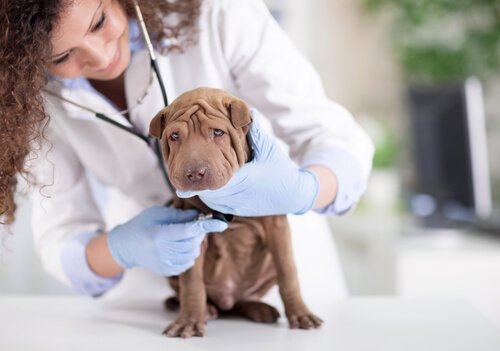Can Dogs Suffer Panic Attacks?

It’s likely that many people don’t know that, just as with humans, dogs suffer panic attacks too. These can be caused by loud noises, an accident on the road or a fight with another dog, among other things. Whatever the situation may be, you should know which situations provoke a panic attack in your dog and what you can do about it.
Why dogs suffer panic attacks

With this issue, various factors can come into play. Among these factors could be the breed of dog, and the circumstances the dog has experienced. For example, a dog that has been abused in the past will show signs of anxiety and fear in tense moments. This might happen, for example, if there is shouting in your house or in a neighbor’s house.
However, this is not very common. The main factors that can cause your dog to suffer panic attacks are usually loud noises. This could be the case with shots, fireworks, thunder and even ambulance sirens.
These panic attacks can make dogs act in different ways. Some might become aggressive, others may try to hide and still others could try to flee from your house or from the scene of the noise. In all these situations, the animal could end up hurting itself due to its panic.
You won’t be able to avoid most of the above situations, but you can do something about it.
What to do if your dog has a panic attack
To avoid injury and further distress in your animal, it’s important that you know what to do. Your dog’s reaction to a panic attack won’t improve if you don’t act in time, and don’t know exactly what you should do to calm it down.
The first thing to do is to realize how you normally respond when you see that your dog is having a panic attack. Generally we tend to mollycoddle or pamper the animal when it gets stressed, with baby talk and cuddles. However, this only reinforces the dog’s behavior, since it could feel like you’re congratulating it for its attitude.
And then there’s the other extreme. Some owners scold their animal for feeling like that. This isn’t good either, since the animal can’t avoid feeling scared. Telling it off will only link its fear and panic with something else that’s negative and it’ll feel doubly scared.
It’s necessary to find a balance between the two extremes. That is, between making your pet feel that nothing is wrong with its behavior, and ignoring it. Sometimes your pet might simply need to be alone.
Techniques to deal with dogs that suffer panic attacks
Some dogs can suffer an uncontrollable fear, and there are some techniques you can try to help your pet improve. For example, for dogs that are scared of loud noises, you could gradually expose your pet to the same sound that scares it. Start by emitting the sound that scares your dog at a low volume, and little by little increase the level.
You can, of course, stop at any time if your dog shows signs of getting anxious. Do this several times. Then the next time it hears fireworks for example, it won’t get scared because it’ll already be used to the sound.
However, if you feel that your pet’s fear is uncontrolled and that you can’t help it cope, taking it to the vet is always a good idea. Your vet can determine the cause and advise you on what to do depending on the situation.
How to tell if your dog is having panic attacks

You should start by observing your dog’s behavior in several different situations to see if it tends to panic. Your pet will give you certain signs that will help you to know how it’s feeling at any given moment. You should be attentive to these signs, such as:
- Audible signs. If your dog cries out or howls to you to go to it.
- Having accidents inside the house. If your dog usually never does this, it’s possible that a panic attack is causing the accidents.
- Destructive conduct. This could happen above all with windows and doors. Your dog may be looking for a way out to be able to be with its owner and feel protected.
Other physical symptoms of panic could be things such as agitated breathing, diarrhea, vomiting, arthritis, anorexia, trembling, depression and others.
Be attentive to your pet. If you see these signs, and have tried the above suggestions but can’t calm your animal down, then take a trip to the vet. He will be the most qualified person to know how to treat dogs that suffer panic attacks.
It’s likely that many people don’t know that, just as with humans, dogs suffer panic attacks too. These can be caused by loud noises, an accident on the road or a fight with another dog, among other things. Whatever the situation may be, you should know which situations provoke a panic attack in your dog and what you can do about it.
Why dogs suffer panic attacks

With this issue, various factors can come into play. Among these factors could be the breed of dog, and the circumstances the dog has experienced. For example, a dog that has been abused in the past will show signs of anxiety and fear in tense moments. This might happen, for example, if there is shouting in your house or in a neighbor’s house.
However, this is not very common. The main factors that can cause your dog to suffer panic attacks are usually loud noises. This could be the case with shots, fireworks, thunder and even ambulance sirens.
These panic attacks can make dogs act in different ways. Some might become aggressive, others may try to hide and still others could try to flee from your house or from the scene of the noise. In all these situations, the animal could end up hurting itself due to its panic.
You won’t be able to avoid most of the above situations, but you can do something about it.
What to do if your dog has a panic attack
To avoid injury and further distress in your animal, it’s important that you know what to do. Your dog’s reaction to a panic attack won’t improve if you don’t act in time, and don’t know exactly what you should do to calm it down.
The first thing to do is to realize how you normally respond when you see that your dog is having a panic attack. Generally we tend to mollycoddle or pamper the animal when it gets stressed, with baby talk and cuddles. However, this only reinforces the dog’s behavior, since it could feel like you’re congratulating it for its attitude.
And then there’s the other extreme. Some owners scold their animal for feeling like that. This isn’t good either, since the animal can’t avoid feeling scared. Telling it off will only link its fear and panic with something else that’s negative and it’ll feel doubly scared.
It’s necessary to find a balance between the two extremes. That is, between making your pet feel that nothing is wrong with its behavior, and ignoring it. Sometimes your pet might simply need to be alone.
Techniques to deal with dogs that suffer panic attacks
Some dogs can suffer an uncontrollable fear, and there are some techniques you can try to help your pet improve. For example, for dogs that are scared of loud noises, you could gradually expose your pet to the same sound that scares it. Start by emitting the sound that scares your dog at a low volume, and little by little increase the level.
You can, of course, stop at any time if your dog shows signs of getting anxious. Do this several times. Then the next time it hears fireworks for example, it won’t get scared because it’ll already be used to the sound.
However, if you feel that your pet’s fear is uncontrolled and that you can’t help it cope, taking it to the vet is always a good idea. Your vet can determine the cause and advise you on what to do depending on the situation.
How to tell if your dog is having panic attacks

You should start by observing your dog’s behavior in several different situations to see if it tends to panic. Your pet will give you certain signs that will help you to know how it’s feeling at any given moment. You should be attentive to these signs, such as:
- Audible signs. If your dog cries out or howls to you to go to it.
- Having accidents inside the house. If your dog usually never does this, it’s possible that a panic attack is causing the accidents.
- Destructive conduct. This could happen above all with windows and doors. Your dog may be looking for a way out to be able to be with its owner and feel protected.
Other physical symptoms of panic could be things such as agitated breathing, diarrhea, vomiting, arthritis, anorexia, trembling, depression and others.
Be attentive to your pet. If you see these signs, and have tried the above suggestions but can’t calm your animal down, then take a trip to the vet. He will be the most qualified person to know how to treat dogs that suffer panic attacks.
This text is provided for informational purposes only and does not replace consultation with a professional. If in doubt, consult your specialist.








